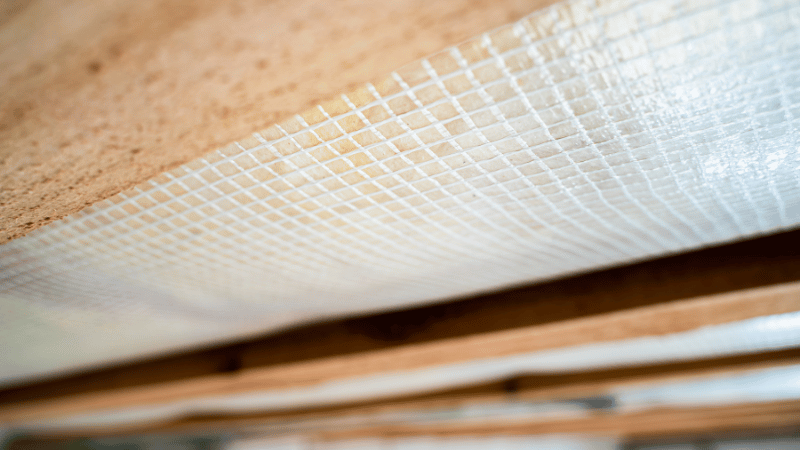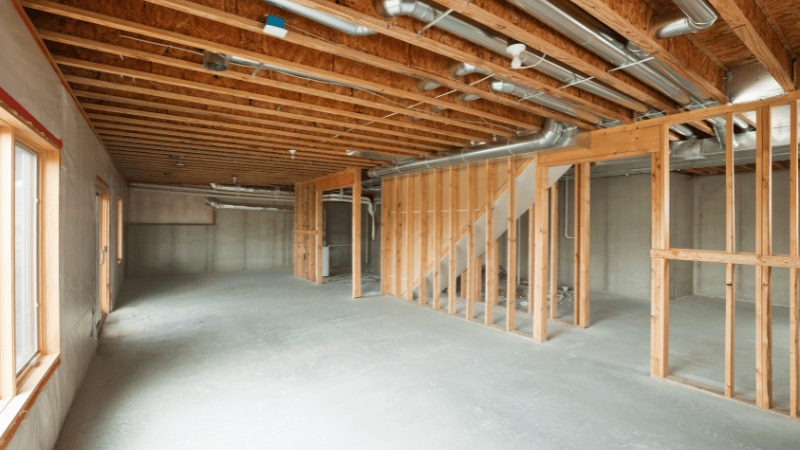A moisture barrier is a silent guardian, offering your home more protection than you might have realized. In the battle against water vapor, this unassuming layer plays an important role in safeguarding your home from a host of potential problems. From the insidious creep of mold to the devastating consequences of flood damage, a well-installed moisture barrier can be the line of defense that distinguishes a house’s lifespan of a mere decade from one that endures for a century.
If you’re intrigued by the idea of creating a more resilient and comfortable home, it’s essential to grasp the significance of moisture barriers in maintaining your living space. Whether you’re dealing with the aftermath of a flood, water damage, or simply striving to establish a healthier and longer-lasting home, we will walk you through the benefits of having a moisture barrier.
Table of Contents
What is a Moisture Barrier?
A moisture barrier, often called a moisture-blocking material, acts as a protective layer designed to keep moisture, water, or vapor from seeping through a surface or area. A moisture barrier, often called a moisture-blocking material, acts as a protective layer designed to keep moisture, water, or vapor from seeping through a surface or area. There are different types of moisture barriers, and the choice depends on the context and desired level of moisture protection.
Types of Moisture Barrier:
There are three types or categories of moisture barrier that are identified as:
- Impermeable: Type 1 vapor barriers are highly impermeable to water vapor. They have a very low permeance rating, typically less than 0.1 perm. This means they offer an extremely effective barrier against the passage of moisture. They are used in applications where a high degree of vapor control is required, such as in extremely cold climates, to prevent condensation within building assemblies. Common materials for Class 1 vapor barriers include polyethylene sheets with very low vapor permeability.
- Semi-Permeable: Type 2 vapor barriers have moderate permeability to water vapor. They typically have a permeance rating ranging from 0.1 to 1 perm. These barriers provide good vapor control in most climates, striking a balance between moisture protection and breathability. Type 2 vapor barriers are commonly used in mixed and cold climates to prevent excessive moisture diffusion while allowing some drying potential. Materials like kraft paper-faced insulation or some coated building papers fall into this category.
- Permeable: Type 3 vapor barriers are relatively permeable to water vapor, with a permeance rating above 1 perm. These barriers allow for significant vapor transmission and are used in applications where vapor control is not a primary concern. They are suitable for warm or hot climates where moisture diffusion is less of a problem, and where allowing drying to the exterior is beneficial. Materials like unfaced fiberglass insulation or some building papers fall into the type 3 category.
How to Know If I Need a Moisture Barrier?
The following are key factors that can help you understand whether you need a moisture barrier inside or not.
- Consider Your Local Climate: Begin by taking your region’s climate into account. If you reside in a place with high humidity or frequent rain, your home is more susceptible to moisture-related problems. Such environments often require moisture barriers to keep the home dry.
- Inspect Crawl Spaces and Basements: Examine your crawl spaces and basement areas carefully. Look for signs of excessive moisture, like damp or wet soil, condensation on walls or pipes, musty odors, or visible mold growth. Any of these signs can suggest the necessity of a moisture barrier.
- Evaluate the Attic: Inspect your attic for signs of condensation. This may indicate inadequate ventilation or insulation in your attic, potentially requiring the use of a vapor barrier.
- Past Water Issues: If your home has encountered water leaks, flooding, or similar problems in the past, this is a clear indicator that measures for moisture control are needed to prevent future occurrences.
- Mold or Mildew Presence: The existence of mold or mildew on surfaces within your home, such as walls, ceilings, or personal belongings, can strongly imply excess moisture. The presence of mold is a clear signal for the need of moisture control.
- Wood Structural Damage: Keep an eye out for indications of wood damage, such as rot or warping, particularly in structural elements like joists, beams, or the subfloor. Such damage can result from ongoing moisture issues.
Installing Moisture Barrier to Protect From Water Damages and Mold Growth
A moisture barrier is like a protective shield for your home, keeping it safe from the harm caused by water damage and mold. When it comes to water damage, this barrier works to stop excess moisture from seeping into your home’s structure, especially in areas prone to issues like flooding. By keeping moisture under control, it helps prevent the need for expensive water damage repair and protects your home from the aftermath of floods and leaks.
On the mold front, a moisture barrier is a hero when it comes to preventing those pesky, unwanted guests. Mold loves damp and humid conditions, but a moisture barrier reduces the moisture levels inside your home. It acts as a barrier between your living space and the outside elements, making sure your indoor environment stays dry and less friendly to mold. This not only keeps your home healthier but also saves you from costly mold remediation.
Using Moisture to Protect Structural Integrity of Your Home
The foundation of your home is essential for its overall structural stability. However, excess moisture present in your crawl space can pose significant issues, as it can accelerate the decay of wooden elements like joists and beams. Wood rot resulting from this moisture isn’t a minor concern; it can lead to substantial structural damage, potentially resulting in significant repair costs. However, by installing a moisture barrier, you can take a proactive step to reduce the moisture levels in your crawl space. This moisture barrier will act as a shield against wood rot, ultimately ensuring the long-term structural integrity of your home and sparing you from unexpected and costly water damage repair.

Can a Moisture Barrier Safeguard Pipes?
Your home’s crawlspace accommodates various pipes that are responsible for supplying both water and power to your household. However, the presence of moisture in this area can be quite problematic. When moisture infiltrates the crawlspace, it initiates a process of rotting, affecting not only the pipes themselves, but also the surrounding materials. This deterioration can lead to the pipes eventually bursting or breaking, which can be both inconvenient and costly. The installation of a moisture barrier serves as an effective solution to this issue, as it keeps the pipes dry, thereby increasing their longevity. By doing so, it helps you avoid the expenses and disruptions associated with repairing or the hassle of water damage restoration.
The Dynamic Duo: Moisture Barrier & Pest Control
A moisture barrier plays a significant role in pest control within your home. By effectively sealing off potential entry points for pests, such as gaps, cracks, and damp crawl spaces, it creates an environment that is less hospitable to unwanted visitors. When moisture is kept in check, it discourages pests like termites, ants, and other insects from thriving, as they often seek out damp areas for nesting. Additionally, by maintaining a dry and less inviting atmosphere, a moisture barrier can help prevent the proliferation of mold and mildew, which can serve as a food source for certain pests. In this way, a well-maintained moisture barrier not only helps in maintaining the overall quality of your living space, but also acts as a defense against pest infestations.
Get In Touch With Our Water Damage Restoration and Mold Remediation Experts
Even if you have a moisture barrier in place, unexpected water damage and mold issues can still arise. It’s important not to delay taking action. Our team of experienced Water Damage Restoration and Mold Remediation specialists is here to provide the help you need. Whether you’re facing a sudden burst pipe, a roof leak, or any other water-related problem, we have the knowledge and equipment to promptly assess the situation and offer effective solutions. We at ServiceMaster by Replacements in Neptune, NJ, are committed to ensuring the well-being of your home from mold and flood damage.
For all of your disaster restoration needs, contact us at (732) 842-6917 or fill out a form on our website.







